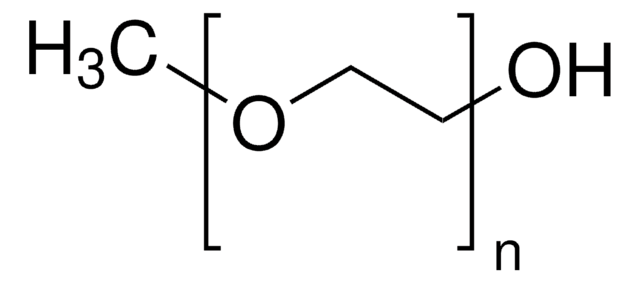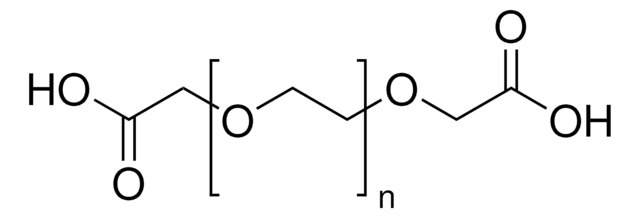17929
O-Methyl-O′-succinylpolyethylene glycol 5′000
Synonym(s):
Polyethylene glycol, O-(Succinyl)-O′-methylpolyethylene glycol 5′000, Polyethylene glycol 5000 monomethyl ether succinate
Sign Into View Organizational & Contract Pricing
All Photos(2)
About This Item
Linear Formula:
CH3O(CH2CH2O)nCOCH2CH2COOH
CAS Number:
MDL number:
UNSPSC Code:
51171641
NACRES:
NA.26
Recommended Products
form
powder
Quality Level
mol wt
Mr ~5100
mp
56-60 °C
Ω-end
carboxylic acid
α-end
methoxy
storage temp.
−20°C
Application
Polyethylene glycol 5000 is used in the construction of biomaterials such as biopolymers, micelles and nanostructures.
Soluble polymer for solid phase synthesis of imines and β-lactams; attaching peptides to PEG
Biochem/physiol Actions
O-Methyl-O′-succinylpolyethylene glycol 5′000 is a modified monomethoxypolyethylene glycol (mPEG) wherein the hydroxyl groups are succinylated by succinic anhydride. This succinylated mPEG can then be used to synthesize tolerogenic mPEG conjugates of peptides. Tolerogenic peptide conjugates are very effective reagents for obtaining epitope-specific immunosuppression of antibody responses to immunopathogenic sites on multideterminant complex protein antigens.
wgk_germany
WGK 3
flash_point_f
Not applicable
flash_point_c
Not applicable
ppe
dust mask type N95 (US), Eyeshields, Gloves
Choose from one of the most recent versions:
Already Own This Product?
Find documentation for the products that you have recently purchased in the Document Library.
Customers Also Viewed
A Bogdanov et al.
Journal of drug targeting, 4(5), 321-330 (1997-01-01)
A co-polymer of O-methyl polyethylene(glycol)-O'-succinate (MPEGs, m.w. 5100) and poly-l-lysine (PL, median m.w. 32700, degree of polymerization 256) has been synthesized by covalent grafting. The resultant MPEGs-PL (30% modification degree of epsilon-amino groups) had a hydrodynamic diameter corresponding to a
V. Molteni et al.
Tetrahedron Letters, 39, 1257-1257 (1998)
M. Joppich, P.L. Luisi
Makromol. Chem., 180, 1381-1381 (1979)
Enhanced stability of PEG-block-poly(N-hexyl stearate l-aspartamide) micelles in the presence of serum proteins.
Diezi TA, Bae Y, Kwon GS.
Molecular Pharmacology, 7, 1355-1360 (2010)
Peptide/protein-polymer conjugates: synthetic strategies and design concepts.
Gauthier MA, Klok HA.
Chemical Communications (Cambridge, England), 21, 2591-2611 (2008)
Articles
Kanjiro Miyata (The University of Tokyo, Japan) provides insights on the rational design of polymeric materials for “smart” oligonucleotide delivery.
Our team of scientists has experience in all areas of research including Life Science, Material Science, Chemical Synthesis, Chromatography, Analytical and many others.
Contact Technical Service





